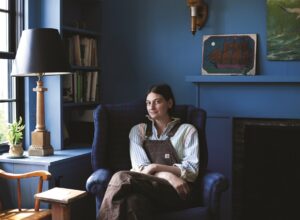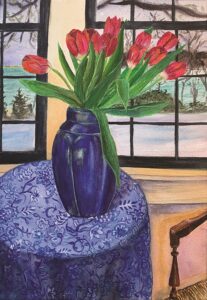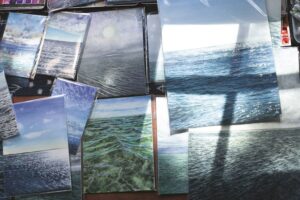Julia Felsenthal likes to paint the same thing over and over again. In her Orleans studio — a small room in her house overlooking Pleasant Bay — stacks of watercolors represent years of work. She began one series of portraits about a decade ago while recovering from an illness. It marked a turning point in her life when painting started to become a central focus. Subsequent bodies of work include paintings of flowers and seascapes. Each series is marked by attention to detail and an insistence on circling around a motif to grasp its totality and visual complexity.

Her subjects and her chosen medium — watercolor — run the risk of feeling quaint. Certainly, it’s territory that has been marginalized in recent art history.
“I’m not resting on fireworks,” says Felsenthal. “I’m interested in making paintings where there’s nowhere to hide.”
Her approach to painting has been informed by other women artists who forged similar paths. In an essay she wrote for Vogue in 2018, Felsenthal surveyed the work of Jane Freilicher, who died in 2014 after a long career painting flowers in front of her studio windows in New York City and Long Island.

“I was interested in the model she set about how to be an artist,” says Felsenthal. “You could just paint what you saw over and over again, and it could be really interesting.”
Figurative artist Alice Neel (1900-1984) was another influence. While working on an article about her, Felsenthal spent a night in the studio Neel kept at her son’s house in Vermont. “I had this weird night communing with the ghost of Alice Neel,” Felsenthal says, laughing. “Writing and learning more about her made me think about the way I had always dismissed the portraits I was making as banal and anodyne and not ‘real art.’ I questioned why I had inherited those ideas.”
Felsenthal developed an early passion for art. “I went to college thinking I was going to major in art but never took an art class,” she says. “I chickened out.” As an undergraduate at Yale, she gravitated instead toward liberal arts. “Writing felt like my birthright, and painting felt like foreign territory,” says Felsenthal, whose mother is the writer Carol Felsenthal. “I was choosing the world that I knew, and I felt too scared to even admit that I wanted something different.”
The Covid era, like her illness some years before, provided Felsenthal with an opportunity to focus fully on her artwork and make up for lost time. “I was a freelance journalist writing about New York City culture at that point,” she says. “Nothing was happening. My work just completely dried up.” In April 2020, she moved with her husband, Jake Beinecke, and their two dogs to Orleans. “I decided that instead of just sitting there fretting about not having any work, I was going to fully turn my attention to painting,” she says.
She also turned her attention toward the water. “I’m really interested that people come here to make paintings of water,” says Felsenthal. “I’m the one millionth person to do this, but everyone is different. You can’t hide how you do things. Paintings are manifestations of how you see things and what your hand is doing. Once you reach a certain point in your ability to make a painting, it becomes really clarifying that you can only make the painting you can make.”

On a shelf in Felsenthal’s studio are four recent watercolors of the ocean, based on photographs she took around Orleans. The paintings feel simultaneously full and empty: simple, straightforward compositions of water and sky. There are no objects to ground the viewer, only rippling waves moving out to the horizon, unstable and impenetrable.
Their plainness, however, requires a different kind of attention. There’s a specific articulation of color in each painting, finely attuned to the qualities of light and weather on a particular day —he water shifts from a sooty gray to cobalt and purplish blues to sea green. There’s drama between the cumulative, obsessive marks of the water and the airy gestures of the clouds, which Felsenthal achieves by wiping away wet paint.
“I started making them during a time where there was a lot of anxiety about Covid,” says Felsenthal. “I had a sense that life was changing in ways that were really uncomfortable. I liked the idea of taking something really big and making it completely digestible.” Despite the intimate scale of the paintings, their emotional tenor remains complex, even contradictory, fluctuating between meditative calm and simmering anxiety.
Like her other bodies of work, Felsenthal’s seascapes are informed by the work of the artist’s chosen teachers. Technically, she says she was intrigued by Vija Celmins’s masterful rendering of watery textures. But Provincetown artist Pat de Groot (1930-2018) was a more significant influence, one who shared a similar fascination with the waters around Cape Cod. Felsenthal identifies a common fundamental question that underlies their work: “How can one thing look so different on a daily basis?”

The Cape provided Felsenthal with not only a new subject for her paintings but also a community and an opportunity to find her voice as an artist. “I encountered a different art world here that I felt was interesting, and I related to it better in some ways,” she says. This summer, Felsenthal will show work at AMZehnder Gallery in Wellfleet, Garvey Rita in Orleans, and JDJ in New York City. “I’m really interested in how these paintings are perceived differently in New York,” says Felsenthal, who currently divides her time between Orleans and Brooklyn.
Despite the increasing recognition of her work, Felsenthal still feels like she’s learning. “I’m making up for my deficits or embracing my differences, depending on what way I look at it,” she says. Her work revels in this complication. There’s virtuosity — the fruit of a diligent student — but also occasional moments of awkwardness and an ill-fitting relationship between elements, qualities often seen in other self-taught artists. What holds her work together is a dedicated vision to interrogate “the ever-changing present,” as she described it in writing about Freilicher’s work.
“I think of myself as a nonfiction painter doing my best to paint what I see and like,” says Felsenthal. “What’s interesting about how I do it is the ways in which I fall short.”



